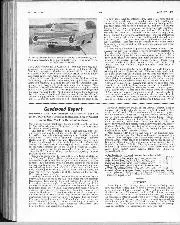
Justice?
According to The Evening News a driver, suffering from sinusitis which caused him to have a severe head pain and his eyes to go out of focus, stopped on M1,…
An Interesting Second-hand Car 14-LITRE SUPERCHARGED ALFA ROMEO
How does a 1929 sports car, admittedly one of the most expensive then in production, compare with the machines of the present day ? That ratios, the gear-box still remains quiet, likewise the supercharger. The best acceleration seemed to be obtained with a steady pressure of the accelerator pedal,
was obviously the principal query which presented itself when the Alfa was handed over for road-test.
The first outstanding feature was the lightness of control. The steering was delicate and accurate, the clutch could hardly be felt and the gear-lever was operated with two fingers. The victories of the Alfa-Roineo in the early days were said to be due not so much to the all-out speed as to their good acceleration and the fact that they could be placed to an inch on a corner, and the road-test certainly confirmed this idea.
Starting is often difficult on supercharged cars, but this trouble was not experienced on the Alfa. Owing to having a Roots-type blower, it is not necessary to add oil to the fuel. The induction system took a considerable time to warm up in Loudon traffic, but once out in the country the working temperature was soon reached. Champion R.I. plugs served equally well for full throttle work and traffic, and a mixture of 75% petrol and 25% benzol was found suitable. The car is well-silenced and slips along at 60 m.p.h. almost without a sound. 75 is reached with a slight depression of the throttle, and in spite of the bright red coach-work, the car did not seem to interest a policeman who was watching the passing traffic. The carburation is good throughout the range, but from low revs, the gears need to be used to get best results. The gear-change is finger-light and almost instantaneous, so this involves no hardship. At 4,000 r.p.m. the speeds are 40, 60 and 75 m.p.h. In Spite of not having any constant-mesh for a quick jab sometimes caused a backfire. Probably a blanking-plate in front of the radiator would have helped but the running temperature could not be discovered owing to the thermometer on